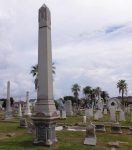 Harris, John Woods (1810-1887) – Texas legislator, attorney and special counsel to the US Supreme Court – Mr. Harris came to Texas from Virginia in 1837 after earning his law degree. He settled in Brazoria County and established a law partnership with John A. Wharton and Elisha M. Pease. When Harris became a member of the Texas bar, the Republic of Texas consisted of only four judicial districts. Harris and Pease (Mr. Wharton had died) divided the work and presented arguments in all the most important cases before the district courts and the Supreme Court of Texas when it was organized in 1840. Harris was elected to the House of Representatives of the Fourth Congress in 1839 where he introduced a bill abolishing the Mexican law and establishing common law as the law of the land. This concept was incorporated into the Texas Constitution of 1845. Harris was appointed the first Texas state attorney general in 1846 and was subsequently special counsel to represent Texas in the US Supreme Court. After the Civil War, he moved to Galveston and practiced law until his death.
Harris, John Woods (1810-1887) – Texas legislator, attorney and special counsel to the US Supreme Court – Mr. Harris came to Texas from Virginia in 1837 after earning his law degree. He settled in Brazoria County and established a law partnership with John A. Wharton and Elisha M. Pease. When Harris became a member of the Texas bar, the Republic of Texas consisted of only four judicial districts. Harris and Pease (Mr. Wharton had died) divided the work and presented arguments in all the most important cases before the district courts and the Supreme Court of Texas when it was organized in 1840. Harris was elected to the House of Representatives of the Fourth Congress in 1839 where he introduced a bill abolishing the Mexican law and establishing common law as the law of the land. This concept was incorporated into the Texas Constitution of 1845. Harris was appointed the first Texas state attorney general in 1846 and was subsequently special counsel to represent Texas in the US Supreme Court. After the Civil War, he moved to Galveston and practiced law until his death.
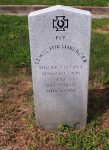 Hirshburger , Lewis (1820-1902) – Member of Singer’s Secret Service Corps – During the Civil War, a small battery of Texas soldiers were stationed in La Vaca (now Port Lavaca) to protect Matagorda Bay from Union advances. In the fall of 1862, a Union armada attacked the town and port. Infuriated by their brazenness, Private Edgar Singer, a gunsmith and the nephew of the inventor of the Singer Sewing Machine, began experimenting with small charges of gunpowder in a water-filled barrel. He was convinced he could develop an underwater mine. After several demonstrations of the mine’s destructive powers, Singer was ordered to report to General John Magruder at Houston (see Magruder below) who was charged with recapturing Galveston from the Union (which he did). When Magruder witnessed the device, he ordered Singer to report to the commanding District of the Gulf in Alabama. There he perfected his device and the underwater mine took its place in military defense.
Hirshburger , Lewis (1820-1902) – Member of Singer’s Secret Service Corps – During the Civil War, a small battery of Texas soldiers were stationed in La Vaca (now Port Lavaca) to protect Matagorda Bay from Union advances. In the fall of 1862, a Union armada attacked the town and port. Infuriated by their brazenness, Private Edgar Singer, a gunsmith and the nephew of the inventor of the Singer Sewing Machine, began experimenting with small charges of gunpowder in a water-filled barrel. He was convinced he could develop an underwater mine. After several demonstrations of the mine’s destructive powers, Singer was ordered to report to General John Magruder at Houston (see Magruder below) who was charged with recapturing Galveston from the Union (which he did). When Magruder witnessed the device, he ordered Singer to report to the commanding District of the Gulf in Alabama. There he perfected his device and the underwater mine took its place in military defense.
Hitchcock, Lent Munson (1816-1869) – Naval officer and civic leader – Born in Connecticut, Hitchcock visited Galveston Island when he was a cabin boy in 1828. He moved to Galveston in 1836 and was subsequently named the island’s first harbor master, a position he held for thirty years. His business interests included retail, insurance, railroads, and real estate including the land on which the town of Hitchcock (on the mainland) is named in his honor. He served eight terms as City Alderman, four terms as treasurer; several times he served as acting mayor and council clerk. He was a charter member of the oldest firehouse in Texas. He was a Mason, Odd Fellow and active in Trinity Episcopal Church.
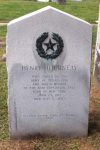 Journey, Henry (1815-1870) – Cabinet Maker – Following Texas independence from Mexico, Journey established a cabinet shop/lumberyard/stable in Galveston that employed as many as twenty men.
Journey, Henry (1815-1870) – Cabinet Maker – Following Texas independence from Mexico, Journey established a cabinet shop/lumberyard/stable in Galveston that employed as many as twenty men.
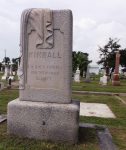 Kimball, Maria Cage (1844-?) – Co-founder of the Wednesday Club – Following the Civil War, Galveston entered what is described by some as the Gilded Age and by the 1890’s, women’s clubs began to crop up. The Daughters of the Republic of Texas was established in 1891 and in that same year, the Wednesday Club was founded in Galveston. Its original intent was to study classic literature and Texas history but its broader mission was to foster fellowship among the city’s leading women, encourage individual study as preparation for discussion by the Club and cooperate in any work which may advance the welfare of humanity.
Kimball, Maria Cage (1844-?) – Co-founder of the Wednesday Club – Following the Civil War, Galveston entered what is described by some as the Gilded Age and by the 1890’s, women’s clubs began to crop up. The Daughters of the Republic of Texas was established in 1891 and in that same year, the Wednesday Club was founded in Galveston. Its original intent was to study classic literature and Texas history but its broader mission was to foster fellowship among the city’s leading women, encourage individual study as preparation for discussion by the Club and cooperate in any work which may advance the welfare of humanity.
 Kirkland, Stephen (1815-1859) – Blacksmith – Kirkland reportedly built the first hook and ladder truck in Texas. That term refers to a fire truck which arrived on the scene with a steam pump (to provide water), a hose (to get the water to the building) and a “hook and ladder.” The ladder gained access to the upper floors and roof of the burning building. The hook was a pole with a pike that allowed fire fighters to pull down walls and to check for fire in undetected places.
Kirkland, Stephen (1815-1859) – Blacksmith – Kirkland reportedly built the first hook and ladder truck in Texas. That term refers to a fire truck which arrived on the scene with a steam pump (to provide water), a hose (to get the water to the building) and a “hook and ladder.” The ladder gained access to the upper floors and roof of the burning building. The hook was a pole with a pike that allowed fire fighters to pull down walls and to check for fire in undetected places.
 Kopperl, Moritz (1826-1883) – Banker, businessman and legislator – Born in Moravia (a region of the Czech Republic), Kopperl immigrated to the US to live with his uncle in Mississippi. He came to Galveston in 1857 and founded a dry goods store which flourished until the store burned during the Civil War. Following the War, he exported cotton but soon began importing coffee and made Galveston one of the largest coffee-importing ports in the world. In 1868, he became president of the Texas National Bank and brought it back from near failure. He also brought one of the area railways back to financial stability. As a city councilman, he developed Galveston’s shipping facilities and developed the means to reduce Galveston’s debt. Elected to the state legislature, he played a significant role in refinancing the government of Texas.
Kopperl, Moritz (1826-1883) – Banker, businessman and legislator – Born in Moravia (a region of the Czech Republic), Kopperl immigrated to the US to live with his uncle in Mississippi. He came to Galveston in 1857 and founded a dry goods store which flourished until the store burned during the Civil War. Following the War, he exported cotton but soon began importing coffee and made Galveston one of the largest coffee-importing ports in the world. In 1868, he became president of the Texas National Bank and brought it back from near failure. He also brought one of the area railways back to financial stability. As a city councilman, he developed Galveston’s shipping facilities and developed the means to reduce Galveston’s debt. Elected to the state legislature, he played a significant role in refinancing the government of Texas.
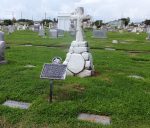 Labadie, Nicholas Descomps (1802-1867) – Physician, pharmacist and entrepreneur – Born in Ontario, Canada, Labadie traveled to Missouri to study for the priesthood under the two men who would eventually lead the Catholic Church in Texas. By 1828, he decided to forgo the priesthood and become a doctor. He mastered both medicine and pharmacology and moved to Louisiana, later establishing a practice in Anahuac (in eastern Harris County) where there was a military garrison. He served both the military post and the civilian population. In 1836, he was appointed surgeon of the first regiment of regulars and tended the wounded at the Battle of San Jacinto (where he also translated Santa Anna’s surrender to Sam Houston). When he returned home, he found it ransacked and that his family had fled. He eventually moved his family to Galveston where he practiced medicine, sold pharmaceuticals and sundries such as paint and paper. He invested in real estate, operated a boarding house, built the first Catholic Church and operated Labadie’s Wharf from the foot of 26th Street.
Labadie, Nicholas Descomps (1802-1867) – Physician, pharmacist and entrepreneur – Born in Ontario, Canada, Labadie traveled to Missouri to study for the priesthood under the two men who would eventually lead the Catholic Church in Texas. By 1828, he decided to forgo the priesthood and become a doctor. He mastered both medicine and pharmacology and moved to Louisiana, later establishing a practice in Anahuac (in eastern Harris County) where there was a military garrison. He served both the military post and the civilian population. In 1836, he was appointed surgeon of the first regiment of regulars and tended the wounded at the Battle of San Jacinto (where he also translated Santa Anna’s surrender to Sam Houston). When he returned home, he found it ransacked and that his family had fled. He eventually moved his family to Galveston where he practiced medicine, sold pharmaceuticals and sundries such as paint and paper. He invested in real estate, operated a boarding house, built the first Catholic Church and operated Labadie’s Wharf from the foot of 26th Street.
 League, John Charles (1850-1916) – Financier and City Father – Formerly a Karankawa Indian village, League City, Texas is on Clear Creek and Magnolia Bayou, equidistant from Houston and Galveston, in Galveston County. Mr. League acquired the land in 1893 and, even though he kept his residence in Galveston, he was committed to the growth and prosperity of his township. He platted the property with roads, parks, churches and schools. He donated land to ensure a thriving community: a place to play, to learn and to worship. At the 2010 census, League City has a population of almost 84,000 residents.
League, John Charles (1850-1916) – Financier and City Father – Formerly a Karankawa Indian village, League City, Texas is on Clear Creek and Magnolia Bayou, equidistant from Houston and Galveston, in Galveston County. Mr. League acquired the land in 1893 and, even though he kept his residence in Galveston, he was committed to the growth and prosperity of his township. He platted the property with roads, parks, churches and schools. He donated land to ensure a thriving community: a place to play, to learn and to worship. At the 2010 census, League City has a population of almost 84,000 residents.
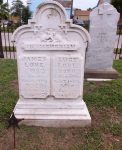 Love, James (1795-1874) – Judge and legislator – Love and his family moved to Texas in 1837 and settled in Galveston after a successful military career (War of 1812), an established law practice and a stint in the Kentucky House of Representatives. Even though he was a bitter enemy of both Sam Houston and Mirabeau B. Lamar (early Texas presidents), he was appointed judge of the first judicial district and clerk of the federal court in Galveston. After the Civil War, he was elected the first judge of the Galveston and Harris County Criminal District but was removed (as were the governor and most officials) by the military commander, accused of being an “impediment to reconstruction.” He was in poor health during the later years of his life.
Love, James (1795-1874) – Judge and legislator – Love and his family moved to Texas in 1837 and settled in Galveston after a successful military career (War of 1812), an established law practice and a stint in the Kentucky House of Representatives. Even though he was a bitter enemy of both Sam Houston and Mirabeau B. Lamar (early Texas presidents), he was appointed judge of the first judicial district and clerk of the federal court in Galveston. After the Civil War, he was elected the first judge of the Galveston and Harris County Criminal District but was removed (as were the governor and most officials) by the military commander, accused of being an “impediment to reconstruction.” He was in poor health during the later years of his life.
 Lufkin, Abraham P. (?-?) – Cotton merchant and city councilman – Not much is known about Captain Lufkin except that he was a close friend to Paul Bremond, the president of the Houston, East & West Texas Railway, who was responsible for building the rail line through a portion of Angelina County, Texas where the town of Lufkin sits today. There is strong evidence that the town was named for Captain Lufkin.
Lufkin, Abraham P. (?-?) – Cotton merchant and city councilman – Not much is known about Captain Lufkin except that he was a close friend to Paul Bremond, the president of the Houston, East & West Texas Railway, who was responsible for building the rail line through a portion of Angelina County, Texas where the town of Lufkin sits today. There is strong evidence that the town was named for Captain Lufkin.
 Magruder, John Bankhead (1807-1871) – Soldier – According to a friend, “Magruder was a born soldier…He would fight all day and dance all night. He wrote love songs…and won an heiress rich beyond comparison.” He fought for the United States Army (1830-1861), the Confederacy (1861-1865) and Emperor Maximilian of Mexico (1865-1866). Possibly his greatest achievement was the recapture of Galveston from the Union in 1863. He married Esther Henrietta von Kapff in 1831 but only saw his family on brief furloughs in Baltimore. His wife visited twice (1854-55 and 1856) in Galveston. Most of his friends thought he was single.
Magruder, John Bankhead (1807-1871) – Soldier – According to a friend, “Magruder was a born soldier…He would fight all day and dance all night. He wrote love songs…and won an heiress rich beyond comparison.” He fought for the United States Army (1830-1861), the Confederacy (1861-1865) and Emperor Maximilian of Mexico (1865-1866). Possibly his greatest achievement was the recapture of Galveston from the Union in 1863. He married Esther Henrietta von Kapff in 1831 but only saw his family on brief furloughs in Baltimore. His wife visited twice (1854-55 and 1856) in Galveston. Most of his friends thought he was single.
Please see Galveston Broadway Cemeteries, Part 1 and Part 3 for more listings

